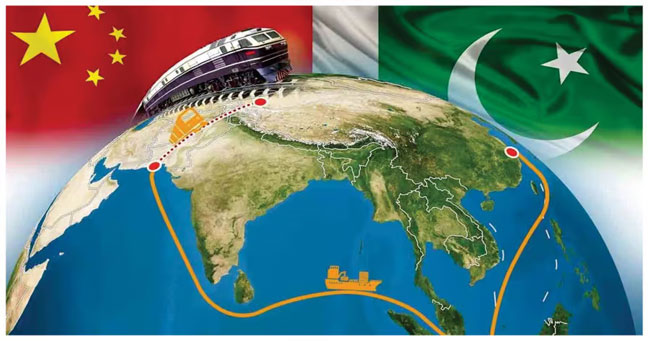The China-Pakistan Economic Corridor, which includes the route from Kashgar to Gwadar, represents a significant achievement in modernizing and integrating the region, particularly for Pakistan and China.
This “new Silk Road” aims to boost economic activity, trade and connectivity, with Gwadar Port becoming a crucial hub.
The CPEC establishes a major trade route, potentially reducing reliance on existing, more vulnerable routes. The corridor connects Gwadar Port to Kashgar, integrating Central Asia, South Asia and the Middle East. The CPEC projects, including infrastructure development and energy initiatives, are expected to drive economic growth in both Pakistan and China. The corridor aims to foster economic interdependence and cooperation among regional countries. The CPEC projects, such as industrial zones and infrastructure development, are anticipated to create numerous job opportunities. The CPEC involves the construction and upgrading of highways and railways, connecting Gwadar to Kashgar. The Gwadar Port acts as a crucial node for trade, connecting global shipping routes and offering access to Central Asia.
The CPEC includes energy projects, such as power plants and transmission lines, to address Pakistan’s energy crisis. The CPEC enhances the strategic importance of Pakistan and China in the region. The CPEC is seen by some as a way for China to expand its influence in the region, potentially countering US influence. The corridor’s development is also seen as a potential factor in promoting regional peace and stability. Pakistan faces internal security challenges, which could impact the corridor’s progress. External factors and potential interference could also affect the project’s success. Ensuring the long-term sustainability and benefits of CPEC remains a crucial aspect.
In essence, the Kashgar to Gwadar route, as part of CPEC, is a landmark achievement with the potential to reshape the economic and strategic landscape of the region. While challenges exist, the corridor’s development holds significant promise for both Pakistan and China.
Signing a raft of energy, trade and investment agreements, the Chinese President inaugurated Balochistan’s Gwadar Port, which is part of the 3,000 km-long strategic China-Pakistan Economic Corridor that could radically alter the regional dynamics of trade, development and politics. Gwadar is one of the least developed districts in Balochistan province. It sits strategically near the Persian Gulf and close to the Strait of Hormuz, through which 40 per cent of the world’s oil passes. The construction and operation of this multi-billion dollar deep-sea port at Gwadar was contracted to a Chinese company in 2013 and some argue that the port could turn into China’s naval base in the Indian Ocean, enabling Beijing to monitor Indian and American naval activities, which is totally wrong.
The Pak-Iran pipeline is on hold, the World Bank-backed Central Asia South Asia Electricity Transmission and Trade Project has to contend with security issues relating to the passageway through Afghanistan and importing power from India has to wait for core issues between the two countries to be resolved.
Energy-poor Pakistan certainly seems to have found a saviour in China, which has promised to stand by the country in its dark hour, as parts of the country suffer power cuts for up to 18 hours a day. The economic corridor will be a monument of the century, benefitting over two billion people in the region.
At the beginning, we believed that the projects conceived under CPEC would ease Pakistan’s energy shortages and make a substantial difference in the long term, with both generation and transmission covered. But it went otherwise because of the very high per unit cost. The agreements with IPPs seem irrational and illogical. The successive governments of Pakistan did not take care of the unaffordable cost of electricity. Unbelievable electricity prices have badly damaged the economic interests of the country. The CPEC project includes building new roads, an 1,800 km railway line and a network of oil pipelines to connect Kashgar in China’s western Xinjiang region to the port of Gwadar.
This initiative includes the New Silk Road, which will link China with Europe through Central Asia and the Maritime Silk Road to ensure a safe passage of China’s shipping through the Indian Ocean and the South China Sea. Some experts argue this initiative can bring greater cohesion in South Asia, one of the world’s least economically integrated regions. At the same time, the new Silk Roads are bound to intensify ongoing competition between India and China – and between China and the US – to invest in and cultivate influence in the broader Central Asian region. India has long had its eyes on energy assets in Central Asia and Afghanistan, even as China has gobbled many of these up in recent years. The US has announced its own Silk Road initiative in the broader region. India is concerned about China’s growing investment in Pakistan, particularly its recent decision to fund a new batch of nuclear reactors.
The economic corridor is unlikely to be successful unless there is peace in Balochistan, a province embroiled in conflict. Militant groups opposed to foreign-funded investment are active in the region, with some of them also having attacked Chinese engineers working on the port. The recent Pak-Afghan-China meeting in Beijing was aimed at the inclusion of Afghanistan in the CPEC to ensure peace in the region. The recent target killing of nine bus passengers in Balochistan has again put the fate of CPEC in doubt in the province. To safeguard the future of CPEC, we will have to crush Indian-sponsored BLA and TTP terrorists in Balochistan and KP.


















